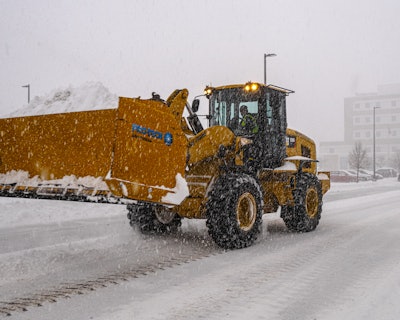
When asked to describe last year’s snow season, many snow professionals chose the same word: steady.
Sure, the snow industry has experienced several roadblocks in recent years—supply chain, COVID and labor issues to name a few—but many professionals are confident about the coming season.
“I think the snow industry is booming,” says Abel Cruz, owner of Lawnforce in Oak Creek, Wis. “When it snows, somebody must clean it, regardless of how the economy is. This is an industry that’s never going to die because in many regions, people are going to need services. As people keep living in those places and as snow keeps falling down, somebody has to clear it.”
Cruz and other snow industry experts discuss their latest snow season and dive into what they expect for this coming year.
The Past Year
While many industries were impacted negatively by the pandemic, the snow industry weathered the storm fairly well.
“People were investing in homes and doing work themselves in their outdoor spaces, so there were strong sales through COVID,” says Kris Kiser, president and CEO of the Outdoor Power Equipment Institute (OPEI). “I also think (manufacturers) are in a better position relative to product inventory. There were all kinds of issues the past year or so with parts, engines and other components, but that's beginning to sort itself out, so on the inventory side, they’re OK.”
Kiser adds that overall, last year’s snow season was “pretty typical” as far as snowfall rates but that snow events tended to be stronger than in the past.
“It was a modest year, but what we are seeing are significant adverse weather events, either drought, flood and stronger hurricanes, storms, tornadoes and snow and ice events,” Kiser says.
Doug McIntosh, president of McIntosh Grounds Maintenance in Milan, Mich., agrees that last year’s snow season was average, but he notes that it’s not the amount of snow that matters, but rather how it falls.
“No two snowfalls are the same. Sixty inches one year versus another year can be totally different just based on whether we got a ton of smaller storms or just a few bigger ones,” McIntosh says.
The Challenges
While COVID, inflation and supply chain issues may continue to affect the snow industry, labor proves to be the reigning champion of obstacles for snow management companies.
“There has been a shift in individuals' attitudes and work ethics, and we have had an increase in labor costs even though the skill set hasn’t changed,” says Elizabeth Bonadonna, president of Busy Beaver Lawn & Garden, in West Seneca, N.Y. “We started utilizing hiring software that helped connect us with prospective employees.”
McIntosh says that the unpredictable nature of the snow industry makes the labor issue more challenging.
“It’s not like summer where we can predict everything, what time we’re going to work from and till and so on. You can plan a 10- to 12-hour workday in the summer, but a 10- to 12-hour workday in the winter is huge,” McIntosh says. “Plus, every storm is different, so you might think you're going to get 1 inch, and you get 3 inches, and the difference between 1 inch to 3 inches is monumental because that leads to the labor question of ‘do we need everybody? Do we just need half the guys? Are we just salting? Are we going to plow and salt?' It’s about trying to navigate and control the logistics of the unknown.”
While Busy Beaver Lawn & Garden uses a hiring software to help contend with the labor problem, McIntosh says his answer is simple: Pay employees more and don’t lay anyone off.
“We pay more, and everybody’s paid on time, every time,” McIntosh says. “We’re also a little different in that we keep everybody like our full-time guys busy year round, whether it’s snowing or if they work in the shop. We don't have guys on unemployment or something like that.”
Cruz has also increased wages to attract labor.
“It has been a struggle. When I started the business in 2013, I used to pay $11 an hour, but now I have to pay over $20 an hour just to get somebody to work,” Cruz says. “I increase my prices about 3 percent every year, so when economies like this hit, it doesn’t affect the company as much.”
In addition to paying more, Lawnforce also fills the labor gap by recruiting young people right out of high school.
“I hire them in the summer and then they come back in the winter,” Cruz says. "Eventually, every time there’s snow, they call me to find out if there’s work. Even if they can only give me three hours, I take it. At least that’s one property done.”
Other than labor, Bonadonna says lack of equipment and inflation costs have impacted her business.
“It’s challenging to get materials with shortages and delays, and we have had to delay jobs and offer some different products and services. Costs have risen by a considerable amount,” Bonadonna says. “We have noticed some customers are passing on our offers, due to compensating for the cost of materials and labor. However, there have been opportunities to get higher calibers of talent who are interested in growth opportunities. There has been a mindset shift from valuing dollars per hour to a higher value of growth opportunities.”
Bonadonna adds that it’s relationships and communication that help the company overcome those challenges.
“We find the right clients that are willing to share some of these inflation costs,” Bonadonna says. “We communicate with our clients about these rising costs. For equipment issues, we continued working with vendors that we know and trust.”
Looking Ahead
In addition to stronger weather events, Kiser says snow professionals should be on the lookout for changing regulations and new technology.
For example, in California, small off-road engines such as those found in leaf blowers, lawn mowers and other equipment will need to be zero emission starting in 2024.
“There are some exemptions on portable generators, but it changes their classification for emissions compliance,” Kiser says. “The engine manufacturers will deal with that. They will have to make compliant engines, but other than that, I don’t see anything that would be problematic from a regulatory standpoint.”
As far as equipment goes, Kiser says he’s seeing more third-stage units that tout ergonomics and efficiency.
“They have headlights, handwarmers, cupholders, and with the different brushes and attachments, there are just more options out there for snow professionals,” Kiser says. “We’ve seen some innovation coming into the mix. At Equip Expo this year, you're likely to see new innovations in a number of product sectors with batteries, too.”
Finally, Kiser says he expects to see an increase in the intensity of snow events, which could, in turn, be good for the snow business.
“A significant snow will drive sales, and early snow will drive sales,” he says.
Tricks of the Trade
· Expand your space
“We’re growing into our new shop and offices, and that’s been huge for us as far as efficiencies. The guys aren’t on top of each other all winter long in the shop. We’re landscapers and we plow snow, so we’re ‘outside guys.’ If you’ve got so many guys in the shop at one time, cabin fever starts to set in. We’ve got a basketball court and other games, and that was a huge success for our culture because the happier the crew is, the happier I am.” – Doug McIntosh
· Don’t overextend yourself
“I never take more work than I can chew. Every year I get phone calls that start in November, and I have to tell them that I’m full. We don’t take so much so that we struggle. That’s partially what’s been helping me big time in retaining my employees.” – Abel Cruz
· Grow your brand awareness
“We’re able to stand out consistently in a sea of sameness by prioritizing brand awareness. We have developed a strong brand awareness in our community, and when others were backing off on marketing and ads, we doubled down. We attracted top level talent and found individuals who are more efficient with their time in the field and office. Additionally, we leveraged technology and equipment mechanization to increase our communication from field to office and back to the client in a more streamlined manner.” – Elizabeth Bonadonna
· Plan ahead
“Plan for delays and plan to buy product or inventory product in advance. We’re seeing longer lead times across the board so future planning seems to be key. Don’t look for the machine only when you need it. Be mindful of the gasoline marketplace today. Don’t leave fuel in your machines. Run them dry and buy fresh fuel when you get that snow report.” – Kris Kiser


![Doosan Bobcat Wacker Neuson Stack 2ec Js Pb V6e[1]](https://img.greenindustrypros.com/mindful/acbm/workspaces/default/uploads/2025/12/doosan-bobcat-wacker-neuson-stack2ecjspbv6e1.CPyyz8ubHn.png?auto=format%2Ccompress&bg=fff&fill-color=fff&fit=fill&h=100&q=70&w=100)








![Doosan Bobcat Wacker Neuson Stack 2ec Js Pb V6e[1]](https://img.greenindustrypros.com/mindful/acbm/workspaces/default/uploads/2025/12/doosan-bobcat-wacker-neuson-stack2ecjspbv6e1.CPyyz8ubHn.png?ar=16%3A9&auto=format%2Ccompress&bg=fff&fill-color=fff&fit=fill&h=135&q=70&w=240)








